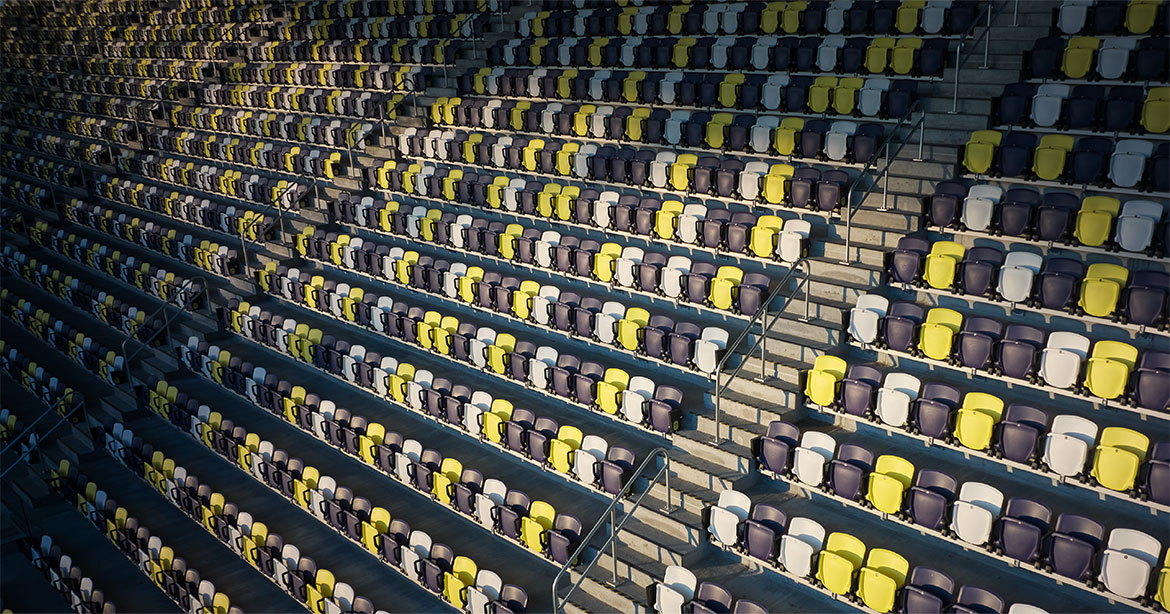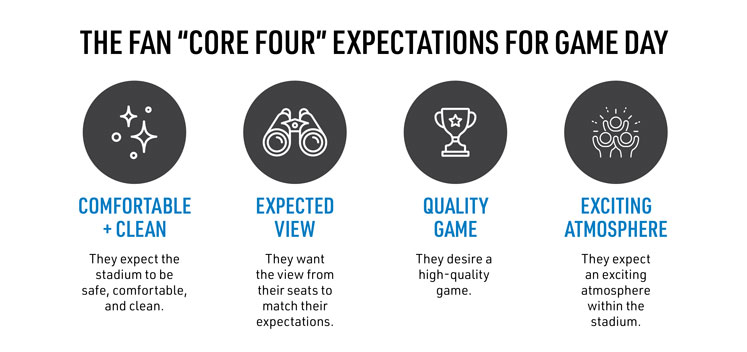
Read time: 9 minutes
The era of constructing high-capacity sports stadiums is on its way out, replaced by a more strategic approach to venue seating.
Prior to the turn of the century, sports venues packed their facilities with as many seats as possible – their primary tactic for increasing ticket sales and revenue. Now, as more than half of these venues near their 30-year benchmark, there is a wave of new and renovated stadiums that follow a new trend: reduced fixed seating. Most prominently seen within baseball, modernized ballparks now prioritize flexible and social spaces over endless rows of standard fixed seats.
Vying for Views
In 2022, MLB saw its lowest total attendance numbers in a non-pandemic season since 2007. To combat reduced attendance, the league implemented policies in 2023 to improve the pace of play and shorten game durations. While these game changes sparked a 9.6% increase in league-wide attendance compared to the 2022 season, a long-term solution to draw in-person attendance should be top of mind.
SPORTS REVENUE TRIANGLE
Facility improvements are critical in crafting the ultimate fan experience and attracting in-person viewership over the long term. Historically, when fans think of attending a game in-person, they visualize parking debacles, crammed seating and expensive concessions. This negative game-day image, born from an outdated facility environment, has led fans to weigh viewing options. Now, more than ever, fans are choosing to watch the game from the best seat in the house: their couch. According to eMarketer, by 2025 nearly 90 million Americans are predicted to watch sports digitally — an almost ten percent increase from 2021. Thus begins a new competition: the live, game-day experience versus at-home entertainment.
These nuanced viewership behaviors will undoubtedly shift the balance of sports business revenues, which have traditionally comprised of media, ticketing and sponsorships. To continue bolstering your in-person ticketing revenue, enhance the fan experience on game days and position your organization to thrive long-term, your facility must evolve to better serve the modern fan.
Fan Expectations for Game Day
According to Deloitte’s Fan Engagement survey, fans of all ages, team loyalties, and sports preferences have a “core four” set of expectations for their live, game-day experience. This study found that meeting these prerequisites is essential for cultivating an engaged fanbase that repeatedly attends in-stadium games.

While seating might not be the first thing that comes to mind, your venue’s ticketing and seating strategy significantly impacts these expectations. A strategic approach to your stadium’s seating is imperative to improve the fan experience, diversify revenue streams, and attract new demographics of attendees.
Nixing the Nosebleeds
Few things are more disappointing than a lackluster game-day view in uncomfortable, shoulder-to-shoulder seats. You find yourself squinting at tiny figures on a distant field and questioning whether staying home would have been a better choice.
“A lot of what gets cut out when you reduce venue capacity are the cheap seats in the upper deck,” explains Erik Johannes, business development executive with Mortenson. “Ironically, the cheap seats in the upper deck tend to be the most expensive to build because they require the most structural work.” Considering the cost and return on investment for a sub-par fan experience, venue owners are repurposing their upper decks to better serve their fanbase.
Built nearly 30 years ago, Progressive Field, home to the Cleveland Guardians, is the tenth-oldest ballpark in MLB. Ready for a revamp, the Guardians’ “Progressive Field Reimagined” renovations aim to extend the life of the ballpark and provide an enhanced fan experience. The priorities for the first phase of the project, completed ahead of opening day 2024, unveiled revolutionized upper deck experiences.
In left field, the Guardians replaced several upper seating sections with the Terrace Garden, a rooftop patio atmosphere open to all 400-level fans that offers grab-and-go beverage stands and great city views. In right field, the team transformed box suites into the Pennant District, a reservable, open-air group space that can host events for up to 1,200 attendees.
Previously restrictive “shipping container” suites (left image), Progressive Field’s new Pennant District (right image) offers 360-degree views and adaptable hosting spaces for groups ranging in size from 100 to 1,200.
Revitalizing these low-impact seating sections provided fans with better views of the city skyline and the game, more easily accessible concessions, and more comfortable gathering spaces. Simultaneously, the Pennant District is flexible in nature and can accommodate a wide variety of group events, during and outside of the baseball season. These strategic preconstruction decisions allowed the Guardians to offer multiple uses for a single space and maximize revenue-generating opportunities.
The anticipation of the renovations has contributed to an increase in game attendance over the last year. Since 2022, Progressive Field has ranked third in year-over-year attendance growth – hosting, on average, almost 8,000 more fans per game in 2023 than they did in 2022. With the first phase delivered and the second phase underway, this renovation positions the team to better host and engage their growing fanbase.
Video created by the “Progressive Field Reimagined” architects, Manica.
Premium over Plastic
Across all sports, stadiums are shifting their focus from fixed seating to premium and club spaces. This trend reflects the changing preferences of fans and the opportunity for stadium owners to maximize revenue.
In a Sports Business Journal article on premium seating trends, Flavil Hampsten – CEO of Elevate Sports Ventures, a sales strategy agency for some of the world’s most high-profile events and venues like Climate Pledge Arena – explains, “In the ‘A’ properties, you can’t build enough beachfront,” comparing premium real estate with premium venue seating.
Premium spaces are particularly in demand by younger demographics of sports fans who crave experiential, photo-worthy moments. As a result, premium seating’s share of total venue capacity is steadily increasing.
Strategically designing your club spaces is extremely important. One of the largest factors in the success of your premium spaces is how flexible they are, a vision that should be captured during the design and preconstruction phase to optimize layouts and utilizations. This adaptability plays a significant role in maximizing your revenue.
In the past, exclusive and intimate suites were the best of the best. While they serve a purpose, your operations are married to a single configuration. Programming premium areas with flexible venue arrangements enables your facility to increase event opportunities and maximize your revenue on non-game days. To achieve best use, it’s crucial to make decisions around flexibility from the onset of your project. Early decisions about space planning will allow your organization to capitalize on anticipatory marketing and selling.
Truist Park markets over 20 rentable spaces on their website with the ability to host small and large gatherings.
Prior to building Truist Park, the Atlanta Braves called Turner Field home. Originally constructed to host the 1996 Olympic and Paralympic Games, the 50,000-seat ballpark hosted the Braves for nearly 20 years. Aligned with the high-capacity tendencies of the time, the venue had a limited approach to premium seating, featuring 58 private suites, three party suites and a single club space. Picking up on emerging trends, the Braves made intentional decisions to increase flexible premium spaces in Truist Park.
Despite reducing total stadium capacity by nearly 8,000 seats, the Braves added six clubs/group gathering spaces spanning over 51,000 square feet. This plethora of group areas – ranging in size from 2,000 to 20,000 square feet – are complemented by an additional 45 private suites. The move towards more flexible, premium spaces has paid off greatly for the team, both in attendance and value.
In their last season at Turner Field, the Braves were listed 13th in home game attendance across the league. Since moving into Truist Park, their attendance has drastically improved, ranking in third place for home game attendance for the 2023 season. The added attendance has led to success on and off the field. Beyond clinching a 2021 World Series win, according to Forbes, the Braves increased their valuation by 72 percent, reaching $2.8 billion, since moving into Truist Park in 2017 – a benefit of investing in a strategic, sports-anchored development.
The No-Seat Ticket
The disappearance of the fixed seat is also driven by another change in fan behavior: mobility. “Fans are fluid these days,” explains Jack Hogan, senior business development manager with Mortenson. “Instead of buying a ticket and sitting in their seat for the entire ballgame, fans want to move around and experience all the venue has to offer.”
Enter the standing-room-only ticket.
As the name implies, these tickets do not come with a seat reservation but access to standing-room plazas with bars and accessible concessions stands. Often marketed as party decks or social zones, these tickets target fans who want a more social, non-restrictive experience. “Oftentimes there's interactive technology or other activations in these spaces to augment the fan experience and provide additional entertainment value beyond the game,” continues Jack.
An added benefit of this ticketing style is that it attracts a different type of audience. According to Deloitte’s 2023 Sports Fan Insights report, Gen Z (those born between 1997 and 2012) “crave social sports experiences,” with community and socialization listed as top necessities for an impactful entertainment experience.
Decisions regarding standing-room-only tickets greatly influence the venue’s design and preconstruction efforts, specifically regarding facility flow and organization. It’s important for your facility’s design to complement the behavior of “fluid fans” who follow a “go, play, watch” pattern, as explained by the Sports Innovation Lab. Ultimately, your venue should make it easier for active fans to explore and engage with various amenities and touch points.
Committed to providing all fans with a top-tier game experience, the Minnesota Twins uncovered that one of their high-end clubs exclusive to season ticket holders at Target Field was underutilized. The club’s previously sealed windows and restricted access made fans feel the space was “too closed off from the game experience,” explained Twins President and Chief Executive Officer Dave St. Peter.
This discovery led the Twins to convert the club into a unique, social bar available to all fans: Truly on Deck (originally named Bat & Barrel). Combining the social atmosphere of a ballpark with the best of sports bars, the all-access club provides open space with multiple bars, plenty of casual seating, bi-folding curtain wall doors and several high-definition displays to bring fans closer to the game.
The Truly on Deck renovation at Target Field has drawn acclaim, receiving the Ballpark Digest Award for Best MLB Renovation in 2018. This improvement elevated the fan experience and continues to situate Target Field as one of the most awarded ballparks in the major leagues.
A Fan-Centric Approach to Stadium Seating
As fans’ needs and expectations evolve, sports organizations must reapproach their stadium’s seating configuration. Rather than focusing solely on capacity, consider a fan-first approach. Upper decks become dynamic gathering spaces, tucked-away suites transform into flexible premium areas, and standing room tickets foster new levels of fandom and connection. A fan-first mentality is key for long-term vitality. As Mortenson Project Executive Taylor Gunkel summarizes, “Once you understand what experience your fans want to walk away with, we can drive your facility design to the needs and budget you’re working with.”













